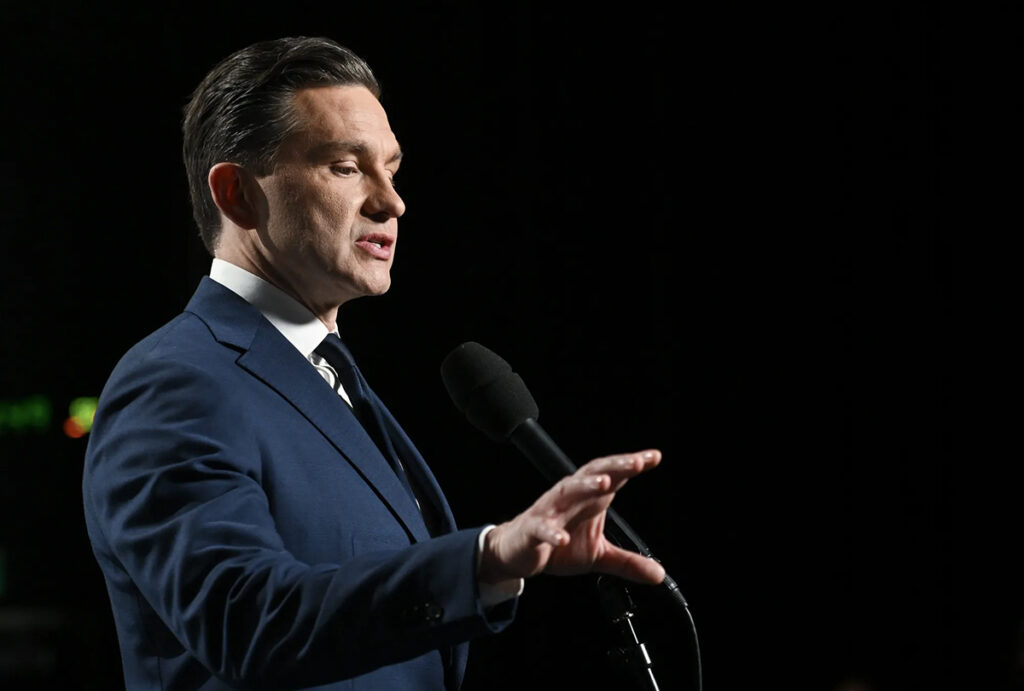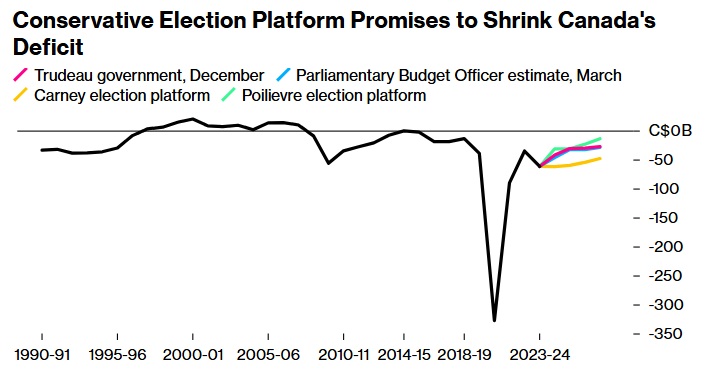
Pierre Poilievre, leader of Canada’s Conservative Party. Photographer: Graham Hughes/Bloomberg
Canada’s Conservative Party is promising to run smaller deficits than the incumbent Liberals as it bets heavily on tax cuts and deregulation spurring an economic boom, especially in the country’s energy sector.
Pierre Poilievre’s plan would reduce the federal government’s shortfall to C$31.4 billion this year, according to the party’s election platform released Tuesday. That compares to the C$46.8 billion estimated by the Parliamentary Budget Office in March. Over the next four years, the Conservatives’ cumulative shortfalls would total C$100.6 billion.
The document promises substantial tax cuts, which the Conservatives say will boost the economy sufficiently to partially offset the loss in revenue. They also include C$20 billion in revenues from retaliatory tariffs imposed on the US this fiscal year, matching the expectation in the Liberal Party’s platform, released Saturday.
Prime Minister Mark Carney announced exemptions to the retaliatory tariffs last week, which are likely to lower revenues from the levies. The Liberals, who are promising deeper deficits to invest in infrastructure and housing, are about five points ahead of the Conservatives in most polls ahead of the April 28 election.

Source: Finance Canada, Liberal Party of Canada, Conservative Party of Canada
The Conservatives have pledged to defer the capital gains tax on investments that are made in Canadian companies for the next two years, at a cost of C$12.7 billion. Getting rid of the previous government’s hike to the capital gains tax inclusion rate will cost about C$12.6 billion over four years. But the party expects these two policies to spur enough investment to raise revenues by C$13.1 billion over that time.
Axing the government sales tax on new homes under C$1.3 million will cost an average of C$1.9 billion annually. The Conservatives also plan to cut the lowest personal income tax rate by 2.25 percentage points to 12.75% from 15%, but the document points to a delayed implementation, with the break costing C$6.5 billion over the next two fiscal years before ramping up to an annual C$13.7 billion by 2028-29.
A Conservative spokesperson said the rate would be cut to 14.25% in 2026, 13.5% in 2027 and 12.75% in 2028. The Liberals are planning an immediate one percentage-point cut to the rate, bringing it to 14% this tax year.
The Conservative platform assumes that tax cuts and deregulation will result in revenue gains, which were included in the platform estimates as a means of offsetting the net new spending costs. Measures to reduce taxes and lower the regulatory burden in the oil and gas sector are expected to bring in C$27.4 billion over the next four years.
“If you think that things like regulations, carbon tax and the oil and gas cap lower productivity, then eliminating them boosts GDP growth,” Trevor Tombe, an economics professor at the University of Calgary, said in a phone interview.
The document offers no estimate for growth in gross domestic product, a key input for revenue estimates. Economists surveyed by Bloomberg expect GDP to expand 1.5% in 2025 in real terms, but analysts are consistently slashing their forecasts for growth as US President Donald Trump’s trade barrage persists.

Source: Finance Canada, Liberal Party of Canada, Conservative Party of Canada, Parliamentary Budget Officer
Carney’s platform pledged C$129.2 billion in net new spending over the next four years, including investments in infrastructure to reduce reliance on the US.
The Liberal leader said Tuesday that Poilievre’s platform relies on “phantom growth” that falls “from the sky” to reduce deficits. “These numbers are a joke. We aren’t in a joke. We are in the worst crisis of our lives,” Carney said.
Neither party is forecasting a return to balanced budgets.
Ian Lee, associate professor at Carleton University’s Sprott School of Business in Ottawa, said the Conservative platform will boost the private sector, while the Liberals emphasize the government as the agent of change.
“There are very clear, factual, empirical differences in the philosophical direction and in the actual concrete promises,” he said. “The Liberals are much more top down and the Conservatives much more bottom up.”
The Conservatives also plan to reduce the size of the federal public service through “natural attrition and retirement,” replacing only two in three government workers who leave. They also intend to slash spending on external consultants, ramping up to C$10.5 billion in annual cuts by 2028-29.
“Lowering a spending initiative doesn’t necessarily affect GDP unless you think it’s addressing a market failure or boosting productivity somehow,” said Tombe.
— With assistance from Randy Thanthong-Knight, Mario Baker Ramirez, Brian Platt, and Melissa Shin
Share This:





 CDN NEWS |
CDN NEWS |  US NEWS
US NEWS 




























